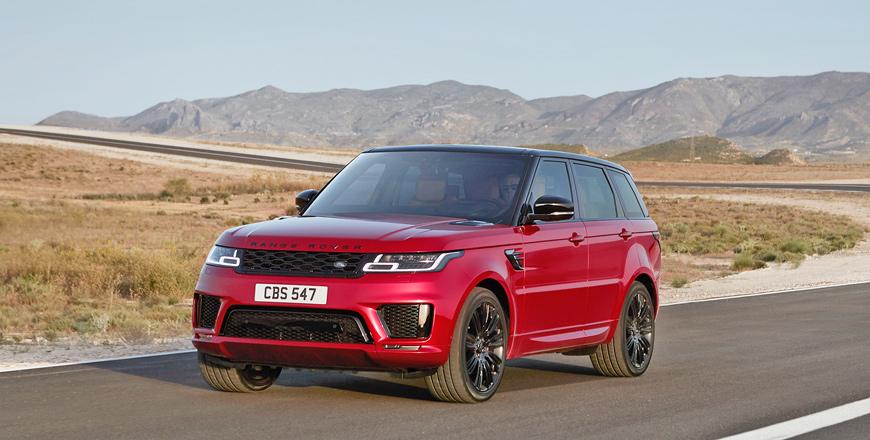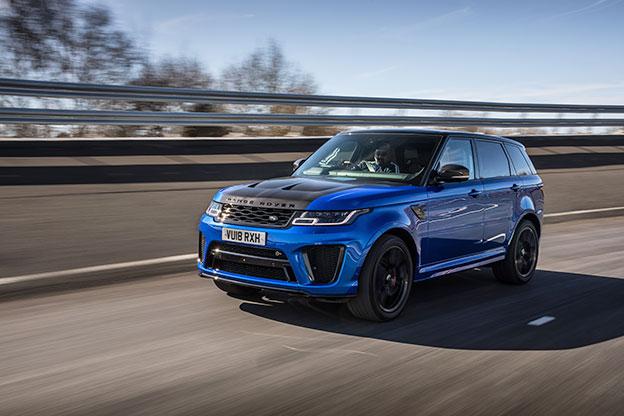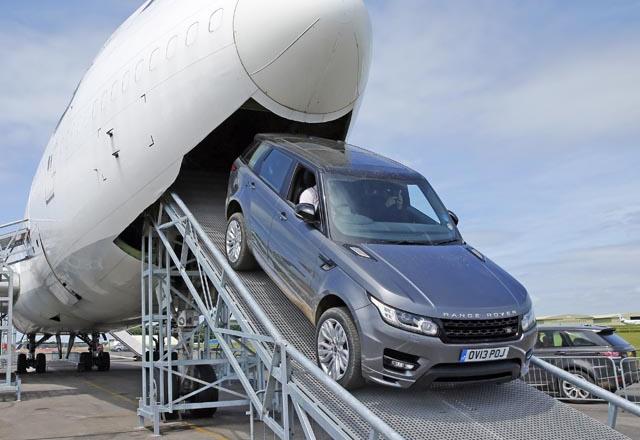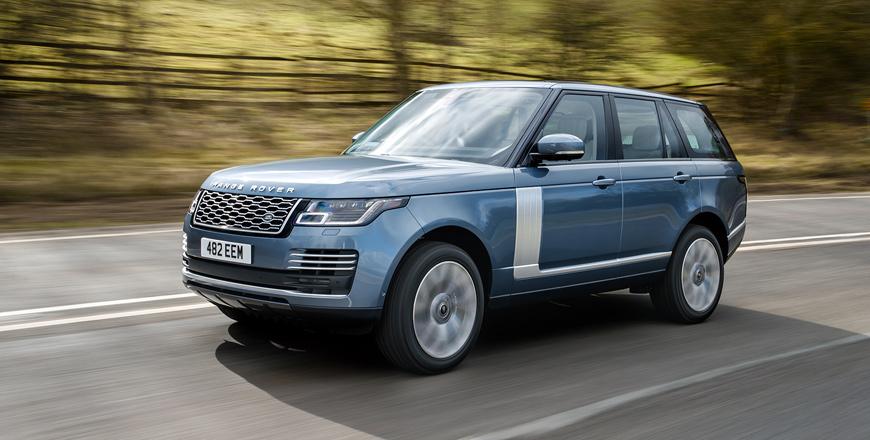You are here
Range Rover Sport V8 Supercharged Autobiography: Smooth operator
By Ghaith Madadha - Nov 19,2018 - Last updated at Nov 19,2018

Photo courtesy of Range Rover
First launched in 2013 and face-lifted in 2018, the latest iteration of Land Rover’s second-to-flagship model, the Range Rover Sport receives new and improved engine options, tech features and mildly revised styling. The sportier and slightly smaller sister to the full-size Range Rover, the Sport range now includes four-cylinder and plug-in hybrid versions to fend off internal competition from recently launched Range Rover Velar and Land Rover Discovery models. With the Velar and Discovery creeping up the land Rover model chain, the Sport’s position hinges, more than ever, on its athleticism.
Grounded and upright
Competing internally with a more luxurious and affordable Discovery for practicality, the low-roof Velar as a cheaper and stylishly sporty alternative and the full-size Range Rover for space, comfort, status and ultimate luxury, the Range Rover Sport’s crux is that it offers the best combination sporty driving, luxury and off-road ability. And in a line-up that includes the brand’s most powerful and quickest SVR skunkworks model, the Range Rover Sport line is best defined by the driven V8 Supercharged model with upscale Autobiography trim and sportier Dynamic package.
Little altered visually, the Range Rover Sport’s mild cosmetic update lends itself to a more assertive and purposeful demeanour. Starting with a slimmer grille and lights with a more angular LED lighting element that is brighter and easier on the eye at night, the revised Sport also features an updated bumper design with boxier horizontal intakes for improved airflow and a more planted and grounded aesthetic. As before, the tall and upright Sport’s floating roofline lends it a more elongated and flowing look, complemented by a new rear spoiler designed to reduce dirt accumulation on the rear windscreen.
Full-blooded delivery
Sitting beneath its high-rise clamshell bonnet, the most powerful non-SVR Range Rover Sport is powered by Jaguar Land Rover’s familiar, evocative and brutally effective 5-litre supercharged V8 engine. Tuned to now produce an additional 15BHP, the revised Sport now develops a whopping 518BHP at 6,000-6,500rpm, while torque output remains as sledgehammer-like in efficacy, with 461lb/ft unleashed throughout a broad and easily accessible 2,500-5,500rpm. Little shy of the rang-topping high performance SVR model’s 567BHP and 516lb/ft state of tune, the driven Supercharged V8 Autobiography model may not be quite as fast, but hardly feels so on road.
Smooth and effortless in delivery, the Range Rover Sport’s distantly faint cruising rumble turns to a full blooded and urgently growling, bellowing and pounding staccato barrage when one meaningfully sinks pedal to metal. Capable of dashing through 0-100km/h in scant 5.3-seconds at full tilt, the Sport can attain 250km/g with the optional Dynamic package as tested, which de-restricts top speed from a nominal 225km/h. Viciously swift and relentless in building speed on the move, the Sport’s vast mid-range torque reserves are an ever-present and accessible, and underwrite its swiftly progressive power accumulation.
Uncanny control
If thirsty next to smaller and lighter cars, the Sport’s 12.8l/100km combined efficiency is restrained for so high a vehicle of 2,390kg, and is aided by a stop/start system and wide but close spread of gear ratios, while its huge 104-litre fuel tank provides generous driving range. Driving all four wheels through a swift and smooth shifting 8-speed automatic gearbox, the Range Rover Sport’s 50:50 front-to-rear torque distribution is automatically re-apportioned to maintain traction, grip, stability and agility on- and off-road. An active locking rear differential and low speed gearbox transfer meanwhile allow for more extensive off-road ability.
Built on an aluminium structure lighter than a steel equivalent and riding on sporty double wishbone front and multi-link rear suspension, the Range Rover Sport also uses a complex system of adaptive air dampers and adaptive anti-roll bars, which combine to provide a combination of on-road comfort and sporting agility that belie a vehicle of this weight and height. Riding upright and high with excellent good visibility, the Sport is settled, smooth and firmly planted on the road at speed. However, when turning into a corner, the way it controls body roll as dampers and anti-roll bars tighten up is nothing short of uncanny.
Comfort and capability
Turning it quite tidily, with but a faint instinct for under-steer assumed, the Sport feels taut and tidy through corners, with height levels of grip as power is redistributed where it needs to go before pouncing out onto a straight. Refined inside from noise and vibrations, the Sports adaptive air suspension provides a forgivingly absorbent and comfortable ride that soaks up and irons out most road imperfections, but the sharpest frequency low speed bumps, over which its attractive and grippy but vast 22-inch alloy wheels and low profile 285/40/R22 tyres can feel slightly firm and heavy. Driver assistance systems have meanwhile improved and include autonomous emergency braking, lane keeping, blindspot and adaptive cruise control features.
Capable on- and off-road, the Sport’s adaptive air suspension automatically lowers at speed but can be raised for improved off-road angles and driving angles, while its Terrain Response system that optimises throttle, braking, differentials and traction control for various off-road conditions. Meanwhile inside, the Sport provides a comfortable and highly adjustable driving position decent rear space and generous cargo room. Finished in quality metals, leathers, soft textures and gorgeous suede-like roofliner the Sport’s luxurious cabin features improved and extensive convenience features, including a gesture operating panoramic sunroof and touchscreen infotainment system.
TECHNICAL SPECIFICATIONS
- Engine: 5-litre, supercharged, in-line V8-cylinders
- Bore x stroke: 92.5 x 93mm
- Compression ratio: 9.5:1
- Valve-train: 32-valve, DOHC, variable timing, direct injection
- Gearbox: 8-speed automatic
- Driveline: four-wheel-drive, low-ratio transfer, locking rear differential
- Ratios: 1st 4.714; 2nd 3.143; 3rd 2.106; 4th 1.667; 5th 1.285; 6th 1.0; 7th 0.839; 8th 0.667
- Reverse/final drive ratios: 3.317/3.31
- Power, BHP (PS) [kW]: 517.8 (525) [386] @6,000-6,500rpm
- Specific power: 103.5BHP/litre
- Power-to-weight: 216.6BHP/tonne
- Torque, lb/ft (Nm): 461 (625) @2,500-5,500rpm
- Specific torque: 125Nm/litre
- Torque-to-weight: 261.5Nm/tonne
- 0-100km/h: 5.3-seconds
- 80-120km/h: 3.3-seconds
- Top speed: 250km/h
- Fuel economy, combined: 12.8-litres/100km
- CO2 emissions, combined: 291g/km
- Fuel capacity: 104-litres
- Length: 4,879mm
- Width: 2,073mm
- Height: 1,803mm
- Wheelbase: 2,923mm
- Track, F/R: 1,692/1,686mm
- Aerodynamic drag co-efficiency: 0.35
- Boot capacity, minimum: 703-litres
- Unladen weight: 2,390kg
- Ground clearance: 278mm
- Wading depth: 850mm
- Towing, braked/unbraked: 3500/750kg
- Suspension, F/R: Double wishbones/integral link, adaptive air suspension, active anti-roll bars
- Steering: Electric-assisted rack & pinion
- Turning circle: 12.39-metres
- Lock-to-lock: 2.7-turns
- Brakes, F/R: 380/365mm ventilated discs
- Tyres: 285/40R22
Related Articles
First launched in 2015 and revised as part of a model-wide mid-life facelift, Land Rover’s fastest, most powerful and sportiest SUV just got
Going above and beyond the usual length and breadth of a new model launch test drive, Land Rover aptly and convincingly proved that off-road ability, sporty on-road handling and high levels of luxury and refinement need not be mutually exclusive attributes as conventional wisdom would have. When first launched in 2005, the Range Rover Sport’s very name seemed an oxymoron, but clever engineering, commitment to off-road heritage and a determination to break the mould, ensured success. Unlike “sports” SUVs that preceded it, the Range Rover Sport doesn’t compromise off-road credentials, while the recently launched second generation only serves to further bend the rules of what is possible.
Launched globally in recent weeks, the Range Rover P400e PHEV is Land Rover’s entry into the full-size luxury hybrid SUV segment.

















